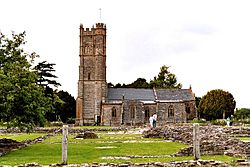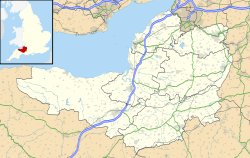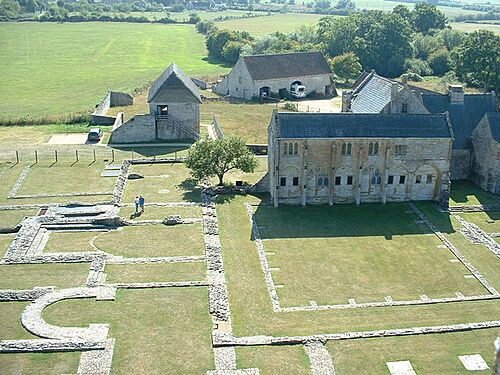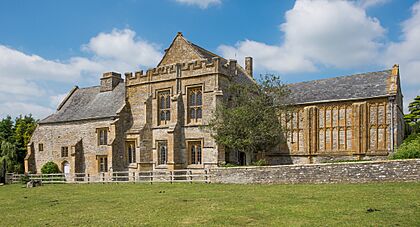Muchelney Abbey facts for kids

The Church of St Peter and St Paul in the background. In the foreground are the ruins of the main abbey building.
|
|
| Monastery information | |
|---|---|
| Order | Benedictine |
| Established | 10th century |
| Disestablished | 1538 |
| People | |
| Founder(s) | Cynewulf, Centwine, Ine, Æthelstan and Æthelred |
| Site | |
| Location | Muchelney, Somerset, England |
| Coordinates | 51°01′13″N 02°48′57″W / 51.02028°N 2.81583°W |
Muchelney Abbey is an amazing historical site in the village of Muchelney in the Somerset Levels, England. It's looked after by English Heritage. When you visit, you'll see the old ruined walls of the abbey buildings. These buildings were first built between the 7th and 16th centuries.
The best-preserved part is the Abbot's House, which is still standing. Right next to the abbey ruins is the local parish church. Some of the stones and decorations from the old abbey were actually used to build this church!
The site includes the remains of a medieval Benedictine abbey. Before that, there was an even older Anglo-Saxon abbey here. The Abbot's House, built in the 16th century, is a special listed building called Grade I. The abbey ruins themselves are protected as a scheduled monument.
The abbey was first started in the 7th or 8th century. It was damaged by Vikings but then rebuilt in the 10th century. The monks who lived here owned and managed land nearby. The abbey grew bigger from the 12th to the 16th centuries. But in 1538, it was closed down during the Dissolution of the Monasteries. Most of the buildings were pulled down, and their stones were used for other local buildings. Luckily, the Abbot's House and a special toilet building called a reredorter survived. Since 1927, the ruins have been open for everyone to visit.
Contents
What's in a Name?
The name Muchelney comes from two old English words. "Micel" means 'big' or 'great'. "Ēg" means 'an island'. So, Muchelney means 'big island'. This makes sense because the abbey was built on dry land surrounded by marshy, often flooded areas in the Somerset Levels. It was like an island in the wetlands!
A Look Back at Muchelney Abbey's History
Early Days and Viking Raids
The abbey's location was like an island in the wet Somerset Levels. People believe a religious building was first built here around 693. A special document, called a charter, was given by King Cynewulf in 762. However, the Benedictine monks didn't settle here until the 10th century.
Later, Vikings attacked the area. Their raids damaged parts of the abbey, so it had to be rebuilt. We don't know exactly who helped restart the abbey. But a document from 1535 names Kings Centwine, Ine, Æthelstan, and Æthelred as founders. Some stories say King Æthelstan helped as a way to make up for something he did, or after winning a big battle.
Life at the Abbey in Medieval Times
The Domesday Book of 1086 was a huge survey of England. It shows that Benedictine Muchelney Abbey owned three islands: Muchelney, Midelney, and Thorney. Back then, the abbey even paid a tax of 6,000 eels each year! These eels were caught from the local rivers and marshes.
Many of the abbey buildings were constructed in the 12th century. The abbot, who was the head monk, successfully took over and managed nearby marshy areas. Around 1308, the abbey built The Priest's House for the local priest. Today, the National Trust looks after this house.
The abbey continued to grow and change. Between the 13th century and its closure, some monks from Muchelney even went to study at the University of Oxford. By the 16th century, the abbey had a main church, a farm, a place for giving to the poor (an almonry), the local parish church, and a stone cross.
The End of the Abbey
In 1538, a big change happened across England. King Henry VIII decided to close down all the monasteries. This event is known as the Dissolution of the Monasteries. The monks at Muchelney Abbey had to give up their home and all its land to the King.
After this, most of the abbey's main buildings were torn down. The stones were then used to build other things in the area. However, some beautiful floor tiles from the monastic church were saved and moved to the nearby Church of St Peter and St Paul. The entire property was given to Edward Seymour. When he was executed in 1552, the land went back to the King.
In 1927, the ruins of Muchelney Abbey were taken over by the government. Today, English Heritage cares for them. The Abbot's House was recognized as a Grade I listed building in 1959, meaning it's a very important historical building.
What You Can See Today
Muchelney Abbey is the second largest abbey in Somerset, after Glastonbury. The main church used to be about 192 feet (58 meters) long and 52 feet (16 meters) wide. Today, you can mostly see the foundation walls of the main building. You can also see parts of the south cloister (a covered walkway) and a wall from the refectory (the monks' dining hall). The cloister still has bits of its arched design and a special ceiling called a fan vault.
The Abbot's House
The Abbot's House is the only building that is still completely standing. It has many well-preserved features. You can see the detailed stonework on the outside. Inside, there's a large room called a great chamber with a fancy fireplace, a carved wooden bench, and stained glass windows. The wooden roof is also very old and interesting.
The Monks' Toilet
One very unusual thing to see is the monks' reredorter, or lavatory (toilet). It's a two-story building with a thatched roof. It's thought to be the only one of its kind left in Britain!
There's also an old barn to the west of the abbey that is a protected historical site.
See also
 In Spanish: Abadía de Muchelney para niños
In Spanish: Abadía de Muchelney para niños




